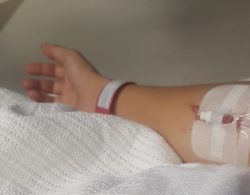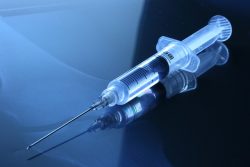Before puberty, migraines are three times more frequent in males than in females but after puberty the tides turn and females are more likely to suffer from migraines than males. An Oxford study found that females are twice as likely to have migraines and that
“brains are deferentially affected by migraine in females compared with males. Furthermore, the results also support the notion that sex differences involve both brain structure as well as functional circuits, in that emotional circuitry compared with sensory processing appears involved to a greater degree in female than male migraineurs.”
The overwhelming belief is that the connection is clear: the hormones kick in for women at puberty and that must be the reason. This begs the questions: 1) Do males have the same hormonal problems before puberty as females do after puberty? If hormones are at root of the problems, then there must be some similarities, right? 2) If female hormones are responsible for migraines, do all females have migraines when they reach puberty? 3) Do migraines cease when hormones stop changing after menopause? 4) What about pregnancy or postpartum, how do hormones impact women then? And finally, 5) Do men stop having migraines after puberty?
Some of the answers to these questions will surprise you and may make you wonder if hormones have anything to do with migraines at all. In this post, I show you that while there are some connections between hormones and migraine they might not be the primary drivers of migraine. The relationship between hormones and migraine is not in the presence of hormonal changes but what those changes require in terms of brain energy, the lack of which causes migraines.
First, I would like to respond in quick the five questions I asked earlier: 1) Do males have the same hormonal problems before puberty as females do after puberty that causes them migraines? The answer to this is no. 2) If female hormones are responsible for migraines, do all females have migraines when they reach puberty? The answer to this also is no. 3) Do migraines stop after menopause? Many women have more migraines and some even start migraines in their menopause, so the answer is no. 4) Do migraine increase or decrease during pregnancy or postpartum? The answer is no during pregnancy, but yes postpartum. 5) Do men stop having migraines after puberty? No they do not.
It is not obvious that the cause of migraines must have anything to do with female monthly cycles and their associated hormones. Given also that many women have migraines after puberty, we are safe to assume that some other factors may play a role. It would be hard to envision a world full of children in which our evolutionary road took women to necessarily experience migraines with their menstrual cycles. So what is the connection to hormones; how do women end up with migraines; and why?
Rather than listing all the hormones that activate throughout the monthly cycle of a woman, let’s take a look at what is happening in the body of that woman backstage, during the hormonal changes. First, in a small review I cover in a few sentences what a migraine is.
Migraine is a collection of symptoms that have an underlying physiological mechanism based on chemical (ionic) imbalance in the brain. Migraine is a neurovascular event that Dr. Charles at UCLA called “spectacular neuro-physiological event” that changes the neurophysiology or chemistry of the brain itself. This can be seen using fMRI technology where oxygenation of brain regions shows where activity occurs during migraine—albeit this does not show why it occurs. The same article also suggests that though medications are available to treat the pain associated with migraines, half the sufferers do not receive any pain relief benefit from the drugs. I find this statement alone interesting because if migraine was truly understood, the pain medication would work for all. This clearly is not the case. To understand what is happening, we must think out of the box and leave behind the hormonal theory of migraines.
Moving Beyond the Hormone Migraine Theory
We now visit the female body all through a month. Let’s start two days after her menstrual cycle has ended. As female, we feel great, no pain, no bleeding, life is awesome. But what we don’t see works hard in the background using up important energy: the brain. Our hormonal changes are happening every moment of the day only we don’t feel it—hormonal changes are directed by the brain. Because we don’t feel the changes, we are ill-prepared for the inevitable day when it reaches a threshold point of not enough brain energy and the migraine starts. This typically happens 2-4 days prior to menses. I do not think migraines are caused by hormones, but rather they are triggered by the lack of energy available to the brain as the hormones cycle. When the brain runs out of energy, a wave of cortical depression begins in some part of the brain. This is what we feel as a migraine.
What actually happens that uses all that energy? After the menstrual cycle is over, the female body immediately prepares for the next menstrual cycle. There is no downtime for rest. The brain turns off one group of hormones and turns on others thereby manipulating how women see the world prior to and during estrus (fertile time). After a menstrual cycle is over, the brain turns on the estrogen to do a few things:
- Prepare the uterus with a new fertile lining to accept the fertilized egg should one arrive and start a new life.
- In order to make such fertilized egg happen, the egg must be prepared in the ovaries so hormones initiate the ripening of a new egg.
- The woman’s body goes through amazing visible changes at this time of the month. If she had pimples, they magically disappear. If she was bloated, her bloating goes away. Her face becomes the most symmetrical it possibly can; the more symmetrical the more sexually appealing she becomes to the opposite sex.
- She becomes extremely attracted to high testosterone males requiring her pheromones to change and to be able to sense a high testosterone pheromone male’s presence. This high testosterone attraction changes after estrus to attraction to low testosterone males for the safety of the child, should mating end in a baby.
With all this activity going on in the female body that she cannot feel, she is in danger of exceeding the threshold of brain energy-shortage without prior notice or preparation. The cost of all of these activities behind the curtains in the female body is very high in terms of brain energy and hydration. These are sex-hormonal functions that only exist for a certain period of time during the female life. Females are known to be born with all of their eggs they will ever ripen for possible babies. Only these eggs are not “ripe” at birth. Every month one egg ripens in one of two ovaries (sometimes in both and sometimes in none). This egg breaks out of the ovary and starts its journey down the ovarian tube where it either gets fertilized by a sperm or not. If the egg is fertilized, it attaches to the wall of the uterus lining—later to become the placenta of the baby—and a new life cycle begins in the mother-to-be. If however there is no sperm able to penetrate the egg, while it descends in the ovarian tube, the egg will have to be cleared from the uterus together with the nutritious blood vessel rich lining created. This happens with the menstrual bleeding. This we can see and feel.
My Theory: Why Hormone Changes are not the Cause of Migraines
As shown earlier, migraines are not equally present in everyone’s life. Other factors, such as genetic predisposition to sensory organ hyper sensitivities (SOHS) that require more energy, may be the cause. Recent research hints at ionic balance (meaning energy available for use) is crucial in maintaining optimal function and the slightest imbalance can cause major problems (Wei et al.).
When the body is tasked with demanding activities the cells responsible for completing those extra tasks are doing extra chores and need extra energy. The brain regulates the creation of extra hormones for the menstrual cycle. The brain manages the clearing of the uterus after the fertile layer was not used.
By the third day after the cycle, the brain is ordering an egg to ripen—this takes extra energy. This is a once a month event. The brain must have extra energy to complete this task. Ever tried to run a marathon on empty or run your car the extra mile without fuel in your tank? Not possible. Something must break. The brain is the logical one for those who are predisposed to SOHS. If their brain runs out of energy, the neurons cannot generate voltage and stop creating neurotransmitters that instruct the production of hormones in the body. This leads to cortical depression and migraine.
Migraine during Pregnancy
Hands up: how many of you had migraines during pregnancy? Up to 75% of migraineurs do not have migraines during pregnancy. Why you may ask? There is more than one reason for this. The first and most important reason is that while the mom-to-be is pregnant, she has no menstrual cycles so the brain has no monthly cyclical job and it need not use extra energy. Even if the pregnancy comes with a menstrual flow here and there—as it sometimes happens—there is no egg that ripens and there is no uterus layer to remove. It is only a bit of bleeding but no extra energy was needed by the brain for this menstrual flow.
The second important factor is that during pregnancy the mom-to-be seems is more cognizant of what her and her baby-to-be needs. She eat more, tends to eat what she craves and is less likely to be good-looking-body conscious during this time. Pickles with ice cream are famous cravings of women. All the nutrients the brain craves for re-creating energy and feed the brain to prevent migraines: salt, calcium, magnesium, and fat that converts to sugar in the brain.
Migraine during Postpartum
After giving birth nearly, nearly all women immediately revert to eating for a good looking body, lose all the baby fat, and get back into the size zero genes. They stop eating brain-healthy after pregnancy (they never realized they ate brain healthy the first place). Nearly all women return to their migraines postpartum as they return to their old dietary habits.
Post-Menopausal and Menopausal Migraines
We are often told that after we enter menopause or are post-menopausal, our migraines will disappear. Yet, I talk to many women, who have more migraines after their fertile period of life has passed. I am one of those women who experienced more migraines in menopause than in early life. Thus, being no longer fertile, no longer ‘hormonal’ does not mean that we become migraine free; further pointing to the lack of connection of migraines to hormonal fluctuations. In menopause, many women are still very body conscious and watch their dress size more than their health. Others, however, recognize the value of a body supporting diet that may not create a body to fit into such small jeans but may be healthier for an older woman. This second group probably stops experiencing migraines (like I did) whereas the first group remains dehydrated and lacks brain nutrition to work those SOHS brains. They end up continuing their migraines as they had them before.
Of course, we already know from my previous posts that migraines are genetic so not everyone abusing her body will end up as migraineur. To be migraine free, everyone, male or female, must follow the rules of brain fuel.
Fuel for Migraines (Hormonal or Not)
What exactly is the fuel for migraines of any kind? I am leading you back to the first post on migraine that tells you what nutrition the brain needs to return to energy and fuel-filled comfortable homeostasis. The brain works on electricity, which requires specific charge differences inside and outside the cell’s membrane. This voltage is created by salt (sodium and chloride) in ample supply. Sodium also retains water inside the cells for hydrations and opens the sodium-potassium gate to allow nutritional exchange. I am also linking you back to the second post on migraines that explains the anatomy of migraines and what actually happens when the brain in not in homeostasis. How a migraine starts is now visible in fMRI. If you follow the posts I linked to and read the book on how to prevent and fight migraines, chances are, you may never have to face another migraine in your life.
Sources:
- Fighting the Migraine Epidemic; A complete Guide. An Insider’s View by Angela A. Stanton, Ph.D. Authorhouse, February 2014. https://www.amazon.com/Fighting-Migraine-Epidemic-Complete-Migraines/dp/154697637X/ref=tmm_pap_swatch_0?_encoding=UTF8&qid=1518636023&sr=8-1
- Why Women Suffer More Migraines Than Men by Patty Neighmond, NOR April 16, 2012 3:17 AM ET http://www.npr.org/blogs/health/2012/04/16/150525391/why-women-suffer-more-migraines-than-men
- Her versus his migraine: multiple sex differences in brain function and structure by Maleki et al. BRAIN. 2012: 135; 2546–2559, http://brain.oxfordjournals.org/content/brain/135/8/2546.full.pdf
- Hormones & desire Hormones associated with the menstrual cycle appear to drive sexual attraction more than we know. American Psychological Association By Bridget Murray Law. March 2011, Vol 42, No. 3 Print version: page 44 http://www.apa.org/monitor/2011/03/hormones.aspx
- Human Oestrus by Steven W Gangestad, Randy Thornhill. The Royal Society, Proceedings B May 2008 http://rspb.royalsocietypublishing.org/content/275/1638/991
- Ovulating Women are STRIPPING Men of their Money. Cal Poly Bio 502 class lecture notes article. A blog about human evolution, economics, and sexual physiology. Why do strippers make more money at different times of the month? By Hayley Chilton http://physiologizing.blogspot.com/2013/01/ovulating-women-are-stripping-men-of.html
- Migraine and Children. Migraine Research Foundation http://www.migraineresearchfoundation.org/Migraine%20in%20Children.html
- Prevalence and Burden of Migraine in the United States: Data From the American Migraine Study II; Richard B. Lipton, MD; Walter F. Stewart, MPH, PhD; Seymour Diamond, MD; Merle L. Diamond, MD; Michael Reed, PhD. Journal Headache; 646:657
- Population-based survey in 2,600 women. Karli et al., The Journal of Headache and Pain October 2012, Volume 13, Issue 7, pp 557-565 http://link.springer.com/article/10.1007%2Fs10194-012-0475-0
- Multisensory Integration in Migraine Todd J. Schwedt, MD, MSCI. Curr Opin Neurol. Jun 2013; 26(3): 248–253
- Unification of Neuronal Spikes, Seizures, and Spreading Depression. Wei et al., The Journal of Neuroscience, August 27, 2014 • 34(35):11733–11743 • 11733














Angela can you help me for everyday tension headaches after mild covid from 12/2021?Can help me salt too?I have not vaccine.
Hi Erika,
I am told that adding salt to water also helps tension headaches. I never have a tension headache so I don’t know. It’s worthy to try: it’s harmless. Try it. Add 1/8th of a teaspoon salt to a cup of water.
Angela
I found your information after believing something similar must be causing my migraines and hoping to prevent future migraines. May I ask which apps you use to help with your progress in migraine reduction? What do you eat to replace electrolytes?
Hi Kaydee,
Migraines are all caused by the same things for all migraineurs and all migraine types. 🙂 I am not using any apps for my migraine since I wrote the book on what to do about migraines instead. The process eliminates migraines completely–the goal is migraine prevention. I have not had any migraines (that I did not cause on purpose) for over 5 years now, nor did those migraineurs who have been through my program. I recommend you read the latest edition of my book “Fighting The Migraine Epidemic: A Complete Guide: How To Treat & Prevent Migraines Without Medicine” and then also join my migraine group where I help those readers who need additional guidance–it is free.
Once you are familiar with the steps, you too will be able to become migraine free.
I am looking forward to seeing you in my group,
Angela
I took 50mg of Topamax with phentermine daily for 1 month only. During that 1 month I had the usual side effects: numbness/tingling in extremities and face and mild mouth ulcers. What happened next was life threatening. At the end of 1 month, I became hypersensitive. My liver function tests were off the charts. I broke out in discoid type rash on my scalp with severe hairloss. I developed Raynauds in my R foot along with arthritic pain. I had other strange skin involvement, almost keratoic in nature. I had biliary pain resulting in ultrasounds, with little found. These symptoms all manifested at one time and persisted for 4 months. These symptoms did not appear until after Topamax was stopped. I thought I had Lupus and I asked my doctor for ANA test and it came back positive. Further testing was inconclusive as to a confirmed DX of SLE (Lupus). I have discovered that this reaction is common with aromatic antieplileptic medication; however, Topamax is a non-aromatic. So that’s safer right? WRONG! Turns out, my specific drug metabolism reacted to Topamax and caused a Lupus-like sickness. This reaction was so severe to be on it a short duration and on a low dose. Millions of people take Topamax without issues, equally, just as many do have issues ranging from mild to severe. The most dangerous reactions include SLLR, DRESS, DILE, AEDR, SJS, TENS, or AHS reactions. These reactions can have an immediate or delayed onset. The delayed onset is more severe in my opinion because it is insidious, meaning it has wreaked havoc on your body before you become aware. When it does show up in some way, it’s too late, the effects are in full swing.
How can you potentially avoid this? By understanding how your body metabolizes medications. Everyone’s body is different when it comes to how their body processes medications on a cellular level. I suspect in my specific case, I have a slow enzyme phenotype that processes toxins slower than average. This results in accumulation of a toxin that my body does not rid of quickly. The scary news is that up to 50% of the Caucasian population is reported to have a slower drug phenotype process.
Going forward, I will have pharmacogenetic testing done to determine what medications to avoid in the future. It could be deadly the next time I have a reaction like this to a new medication. I don’t want to play roulette with my hypersensitive reactions. Readers should research drug types I-IV hypersensitivities and pharmacogenetic testing, which is a great place to start. This may lead them to discover their own reactions and how to best treat their pain and how to avoid dangerous reactions.
Elaine
Thanks Elaine for posting this online as well as sending this to me by email. Scary things. To help others, I am adding here a link that allows others too who got hurt in any shape or form or had any adverse reaction to report that to the FDA. The problem is that even with all the people having adverse reactions, if they don’t report it, the FDA has no idea that there is a problem. Don’t wait for your doctor to report it; chances are your doctor will not report it because many doctors dismiss the adverse reactions to Topamax–and to many other medicines too.
If you have taken any medicines and ended up with any adverse reaction, please file a report online or by sending a mail to the FDA–you can find all information you need at this link.
Thanks Elaine! <3
Hugs,
Angela
Every time I mention a migraine to someone they give their unsolicited remedy. I have for years tracked my migraines on my calendar and watched how they have been hormone related but not sure how to help this. After reading this information, I am much more informed as to why my cycles cause pain. Thank you, this also makes so much more sense to me. Do you have a monthly newsletter or something to include me in via e-mail?
Hi Wendy,
The monthly newsletter is a great idea! Not sure why I did not think of that before. I will sure to start it after the holidays! Thanks for the suggestion. <3
In the meantime, feel free to join our forever buzzing, happy, and busy migraine group where we always discuss the latest and where we all help each other through trying times, like periods, if someone forgot to use the prevention (and many do… we are human after all).
The group is here:
https://www.facebook.com/groups/219182458276615/
We welcome you to join.
Happy Thanksgiving!
Angela